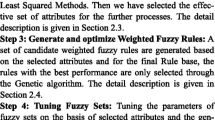Abstract
Heart disease is one of the leading causes of death both the United States and around the world, responsible for the deaths of some 17 million people annually. Many of these deaths could be either prevented or treated more effectively by early detection and subsequent behavioral changes. A model which can accurately predict which patients are at high risk of heart failure would therefore prove valuable for use by healthcare professionals. This paper proposes an approach using a collection of fuzzy inference systems (FIS), arranged in a fuzzy tree to identify which patients are at the highest risk of heart failure. The structure of the fuzzy tree is assumed a priori, then the membership functions and rule base (RB) for each individual FIS in the tree are tuned using a genetic algorithm (GA). The results of the approach are quantified using accuracy, F1 score, true positive rate, and true negative rate, then compared to the results obtained by a variety of different algorithms on the same dataset.
Access this chapter
Tax calculation will be finalised at checkout
Purchases are for personal use only
Similar content being viewed by others
References
“Heart Failure”. https://www.nhlbi.nih.gov/health-topics/heart-failure. Accessed 12 July 2020
Malik, A., Brito, D., Chhabra, L.: “Congestive Heart Failure,” StatPearls [Internet], StatPearl, Treasure Island, FL (2020). https://www.ncbi.nlm.nih.gov/books/NBK430873/
Buchanan, T., et al.: Physician judgement vs model-predicted prognosis in patients with heart failure. Can. J. Cardiol. 36, 84–91 (2020). https://doi.org/10.1016/j.cjca.2019.07.623
Chapman, B., Devore, A., Mentz, R., Metra, M.: Clinical profiles in acute heart failure: an urgent need for a new approach. ESC Heart Fail. 6, 464–474 (2019). https://doi.org/10.1002/ehf2.12439
Castro, J.: Fuzzy logic controllers are universal approximators. Syst. Man Cybern. IEEE Trans. 25, 629–635 (1995). https://doi.org/10.1109/21.370193
Kumari, R., Srivastava, S.: Machine learning: a review on binary classification. Int. J. Comput. Appl. 160, 11–15 (2017). https://doi.org/10.5120/ijca2017913083
Chicco, D., Jurman, G.: Machine learning can predict survival of patients with heart failure from serum creatinine and ejection fraction alone. BMC Med. Inform. Decis. Mak. 20, 1–16 (2020). https://doi.org/10.1186/s12911-020-1023-5
Ernest, N., Cohen, K., Kivelevitch, E., Schumacher, C., Casbeer, D.: Genetic fuzzy trees and their application towards autonomous training and control of a squadron of unmanned combat aerial vehicles. Unmanned Syst. 03, 185–204 (2015). https://doi.org/10.1142/S2301385015500120
Abdullah, A., Fadil, N., Khairunizam, W.: Development of Fuzzy Expert System for Diagnosis of Diabetes, pp. 1–8 (2018). https://doi.org/10.1109/ICASSDA.2018.8477635
Uyar, K., Ilhan, A.: Diagnosis of heart disease using genetic algorithm based trained recurrent fuzzy neural networks. Procedia Comput. Sci. 120, 588–593 (2017). https://doi.org/10.1016/j.procs.2017.11.283
Cordon, O., Gomide, F., Herrera, F., Hoffmann, F., Magdalena, L.: Ten years of genetic fuzzy systems: current framework and new trends. Fuzzy Sets Syst. 141, 5–31 (2004). https://doi.org/10.1016/S0165-0114(03)00111-8
Lewis, G., et al.: Biological phenotypes of heart failure with preserved ejection fraction. J. Am. Coll. Cardiol. 70, 2186–2200 (2017). https://doi.org/10.1016/j.jacc.2017.09.006
Chicco, D., Jurman, G.: The advantages of the Matthews correlation coefficient (MCC) over F1 score and accuracy in binary classification evaluation. BMC Genomics 21, 1–3 (2020). https://doi.org/10.1186/s12864-019-6413-7
Author information
Authors and Affiliations
Corresponding author
Editor information
Editors and Affiliations
Rights and permissions
Copyright information
© 2022 The Author(s), under exclusive license to Springer Nature Switzerland AG
About this paper
Cite this paper
DeGroote, N., Cohen, K. (2022). A Genetic Fuzzy Approach for the Prediction of Heart Failure. In: Rayz, J., Raskin, V., Dick, S., Kreinovich, V. (eds) Explainable AI and Other Applications of Fuzzy Techniques. NAFIPS 2021. Lecture Notes in Networks and Systems, vol 258. Springer, Cham. https://doi.org/10.1007/978-3-030-82099-2_9
Download citation
DOI: https://doi.org/10.1007/978-3-030-82099-2_9
Published:
Publisher Name: Springer, Cham
Print ISBN: 978-3-030-82098-5
Online ISBN: 978-3-030-82099-2
eBook Packages: Intelligent Technologies and RoboticsIntelligent Technologies and Robotics (R0)




